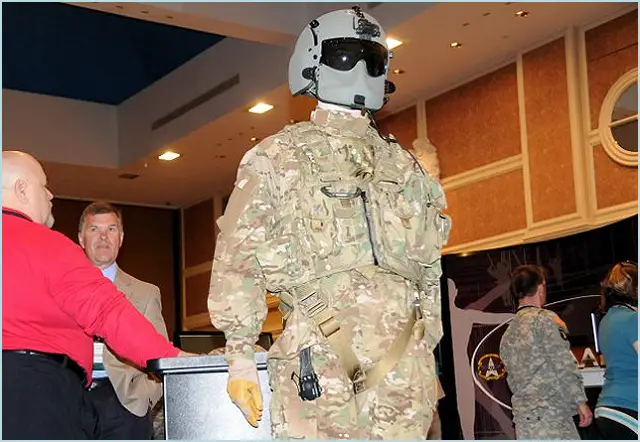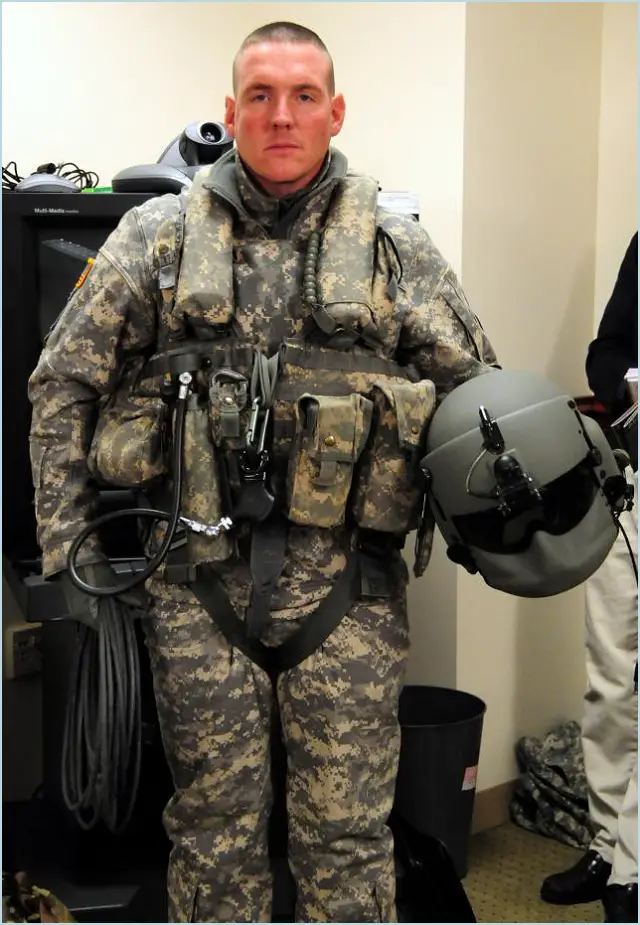The new American lighter-weight Air Soldier Warrior System for rotary-wing aircraft personnel 0904122
| a | |||
Aviation defence equipment technology - United States |
|||
The
new American lighter-weight Air Soldier Warrior System for rotary-wing
aircraft personnel. |
|||
The American Air
Warrior system, an aviation life-support and communications ensemble
first fielded in 2004, and designed for Soldiers who work aboard rotary-wing
aircraft, was designed for use between five and six hours of flight
time. The system is now being used by Soldiers at double that time. |
|||
 The Army plans to eventually replace the Air Warrior system, on display here at the 2012 Army Aviation Association of America conference in Nashville, Tenn., with the lighter-weight Air Soldier System. (Photo Credit: C. Todd Lopez) |
|||
| "Our
aircrews are flying in excess of 11 hours," said Lt. Col. Ian Klinkhammer,
product manager Air Warrior. |
|||
 A Soldier displays the Air Warrior ensemble during a media roundtable, March 2, at the Pentagon with Program Executive Office Soldier. The Army is now evaluating the Aircraft Wireless Intercom System that will mean Soldiers will no longer need to be connected to a helicopter's intercom system with cables, which can be cumbersome and potentially dangerous. (Photo Credit: C. Todd Lopez) |
|||
| Also
in the first sub-increment is the common helmet mounted display, which
includes a common flat-panel display with integrated head tracker and
3D degraded visual environment symbology. "You have a see-through display that has symbology based on the capabilities of the aircraft," said Col. Will Riggins, of Program Executive Office Soldier, the headquarters agency that will eventually field the Air Soldier System. "What the system is designed to do is make the pilot safe." Riggins said that the symbology on the helmet display can illustrate friend, foe, weather and terrain, for instance. "Every time you land, you land in a sand storm, because it kicks up everything around you. So it helps you see where all that is as well, where your friends are, where the bad guys are too -- threats." Also included in increment 1a of the Air Soldier System is an improved cooling vest that is 40-percent lighter than what is currently offered, and a layered clothing ensemble that reduces to three layers what is currently offered as seven. There is also a lightweight environmental control system, an integrated Soldier power and data system, lightweight soft body armor that reduces weight and bulk 30-40 percent, and 72-hour survival items. Sub-iteration 1b of the Air Soldier System includes a wide field-of-view/high resolution head-mounted-display for the AH-64 Apache initially, but with support for future platform sensors. The 1b sub-iteration also includes enhanced laser eye protection and an integrated protective ensemble that includes an integrated flotation device. The legacy Air Warrior system weighs in at about 99.6 pounds. By the time the Army fields sub-increment 1b of Air Soldier System, aviators will have an ensemble that has been reduced in weight to about 72.5 pounds. The Air Soldier System will also reduce the number of batteries from seven to one, and will reduce the number of displays from four to one. Total electronics weight will go from 9.7 pounds to 3.2 pounds, and the number of connections to the aircraft will be reduced from five to three. Right now aviators are still wearing the Air Warrior system. That system is still being improved upon, Klinkhammer said, and right now, just about every Soldier that needs the gear has access to it. "For the most part we're pretty much complete with all fieldings of that gear," Klinkhammer said. The Army is even stockpiling the Air Warrior gear now for the 13th Combat Aviation Brigade, and will field equipment to them in 2013-2014, "to get those guys ready to go into the fight." Part of the current Air Warrior system, the HGU-56/P integrated helmet system with laser eye protection, will get magnetic tracking for Apache Block III pilots, Klinkhammer said. That is coming off the production line now, he said, and will be fielded as the Block III Apache is fielded to units. There is also enough of the Portable Helicopter Oxygen Delivery System equipment available, he said, to field to four Combat Aviation Brigades. That equipment is being used, reset and re-fielded to those who need it. The latest addition to Air Warrior includes two Electronic
Data Manager, or EDM, systems for use aboard aircraft, and they are
enhanced as part of EDM 3.5. That includes a 1.6 GHZ system processor,
two gigabytes of RAM, a sunlight-readable and night vision goggle-compatible
display and the ability to host dynamic terrain and obstacle avoidance. |
|||


























